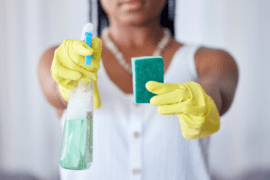With the internet brimming with cleaning hacks, it’s easy to fall for advice that promises quicker, easier chores. Unfortunately, some of these so-called tips are myths that may harm your home rather than help. From outdated practices to commonly misunderstood techniques, here’s the truth about cleaning myths that could be doing more harm than good—and how to clean effectively instead.
Bleach Doesn’t Clean Everything

While bleach is a powerful disinfectant, it’s not a universal cleaner. It won’t remove dirt, grease, or grime; instead, it might mask them by making residue appear lighter. To clean surfaces effectively, use soap and water first to remove visible dirt. Once the surface is dry, dilute bleach and let it sit for at least five minutes before rinsing.
Hair Spray Won’t Save Your Ink-Stained Clothes

The old trick of using hair spray to remove ink stains doesn’t work like it used to. Modern hair sprays often lack the alcohol content needed to dissolve ink. Instead, opt for rubbing alcohol. Place a paper towel under the fabric, pour rubbing alcohol onto the stain, let it sit, and then wash the garment.
Dishwashers Beat Handwashing

Think handwashing dishes is better? Think again. Studies show that modern dishwashers save water, reduce energy consumption, and sanitize dishes more effectively than handwashing. For optimal results, scrape food debris before loading the dishwasher and let its drying cycle do the sanitizing.
Too Much Laundry Detergent Can Ruin Clothes

More detergent doesn’t mean cleaner clothes. Overuse can lead to dark stains or sour smells. A tablespoon of detergent is usually enough for a regular load, and one pod suffices for most loads. Reserve larger amounts for oversized loads like bedding.
Cleaning Solutions Need Time to Work

Spraying and immediately wiping a surface may remove visible grime but not bacteria. Most cleaning solutions require time to work—some need up to 10 minutes. Always read the instructions and allow the cleaner to sit before wiping for maximum effectiveness.
Avoid Vinegar on Certain Surfaces

Although vinegar is versatile, it’s not safe for all surfaces. Its acidity can damage solid wood, marble, granite, and soapstone, and it can corrode metals like iron. Avoid using it on knives or eggs, as it can cause undesirable chemical reactions. Stick to vinegar for glass, tiles, or laminate surfaces.
Your Dishwasher Needs Cleaning Too

A dishwasher isn’t self-cleaning. Food particles, grease, and soap residue can build up, reducing efficiency. Remove debris, wipe down the interior, and run an empty cycle with two cups of vinegar monthly to keep it in top condition.
Microwaving Sponges Can Backfire

Contrary to popular belief, microwaving sponges doesn’t sanitize them—it can actually encourage harmful bacteria to grow. Instead, replace sponges regularly or sanitize them in a dishwasher.
Warm Water Has Its Place in Laundry

Cold water is great for preserving colors, but it doesn’t kill germs. Use warm water for sanitizing items like bedsheets, towels, and baby clothes. Reserve cold water for delicate and dark-colored fabrics to retain vibrancy.
Feather Dusters Aren’t Always Effective

Not all feather dusters work equally well. Ostrich feather dusters, for example, generate static to pick up dust, while synthetic ones may simply scatter particles. For best results, use a microfiber cloth that traps dust effectively.
Green Products Aren’t Always Safer

Natural doesn’t always mean non-toxic. Some “green” cleaners contain volatile organic compounds (VOCs) similar to traditional products. Always check labels and opt for products certified by reputable organizations for safety.
Dust Before You Vacuum

If you vacuum before dusting, you’re likely doubling your work. Dust first to allow particles to settle on the floor, then vacuum to remove them. This ensures a cleaner space with less effort.
Washing Machines Need Maintenance

A funky smell in freshly laundered clothes often signals a dirty washing machine. Hard water deposits and mold can build up over time. Run an empty cycle with hot water and two cups of vinegar to clean the drum and keep your laundry fresh.
Don’t Over-Polish Wood Furniture

Polishing wood furniture too often can cause damage. Limit polishing to every six weeks and always dust before applying polish to prevent trapping dirt.
Wash Your Sheets More Often

Many people wait too long between washing their sheets. Ideally, you should clean them every two weeks—or weekly if you suffer from allergies, night sweats, or illnesses. Don’t forget to wash pillowcases frequently as well.
Frequent Vacuuming Won’t Hurt Your Carpet

Worried about over-vacuuming your carpet? It’s actually excess dust that poses a threat over time. Just be cautious with delicate areas and avoid leaving the vacuum in one spot too long.
Keep Coffee Grounds Out of the Sink

Throwing coffee grounds down the sink can clog pipes as they clump together when wet. Dispose of them in the trash, and for a natural drain cleaner, try a mix of baking soda, lemon juice, and boiling water.
Steam Cleaning Is Safe for Carpets

Steam cleaning effectively sanitizes carpets without soaking them, which prevents mold. While some myths suggest steam cleaning damages carpets, it’s actually one of the best deep-cleaning methods available.
Upgrade Your Mop

Traditional string mops aren’t the most sanitary option. Microfiber mops pick up more dirt and bacteria while avoiding the problem of spreading dirty water around your floors. Consider making the switch for a more hygienic home.












